Bonfires and campfires sound similar. I mean, they are both forms of outdoor fires, so what could be the difference? Surprisingly enough, they differ in size and purpose.
Campfires are small and contained, usually in a fire pit. People use them for heating, light, cooking, and entertainment. On the other hand, bonfires are large and used for celebrations. You also build them differently.
We will discuss everything you need to know about bonfire vs campfire so that you can confidently name your next fiery form of entertainment.
What Is a Bonfire?
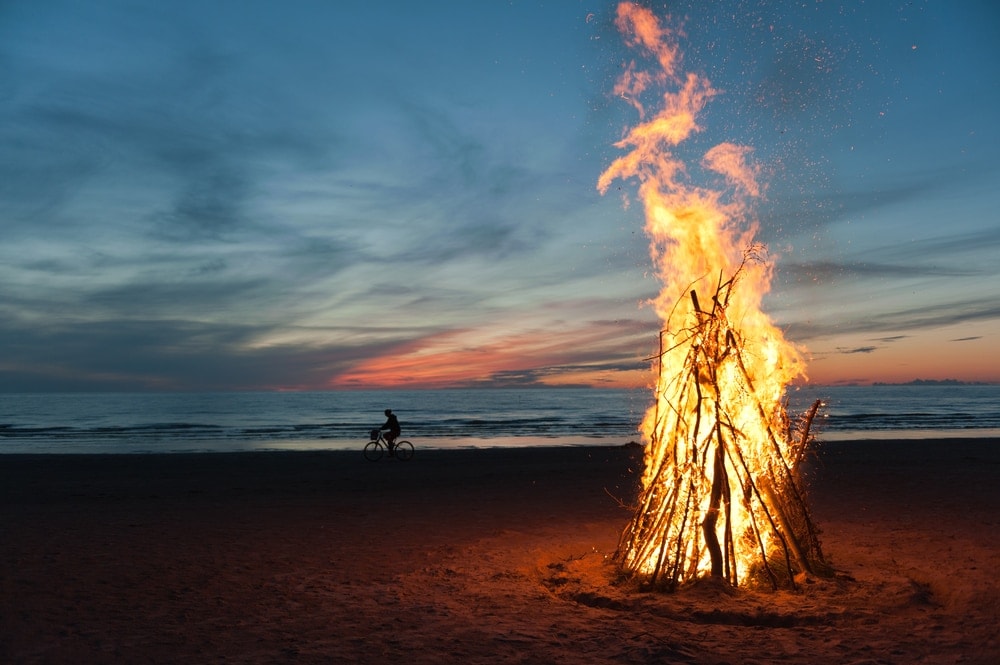
The bonfire definition mentions a large, outdoor, controlled fire. You construct it in an open area far from bushes, shrubs, and trees that could catch fire. Common spots to build them include beaches, fields, and meadows. Keeping them away from flammable wood helps control their spread and protect the surrounding environment.
Purpose of Bonfires
Bonfires have historical use spiritual practices. Their name comes from ancient civilizations that would create a “bone fire” to honor deities. The Celts would hold festivals where they would burn bone piles to scare off evil spirits.
Some ancient groups would worship fire and create a bonfire for their religious use. Other communities would hold bonfires to celebrate their saints.
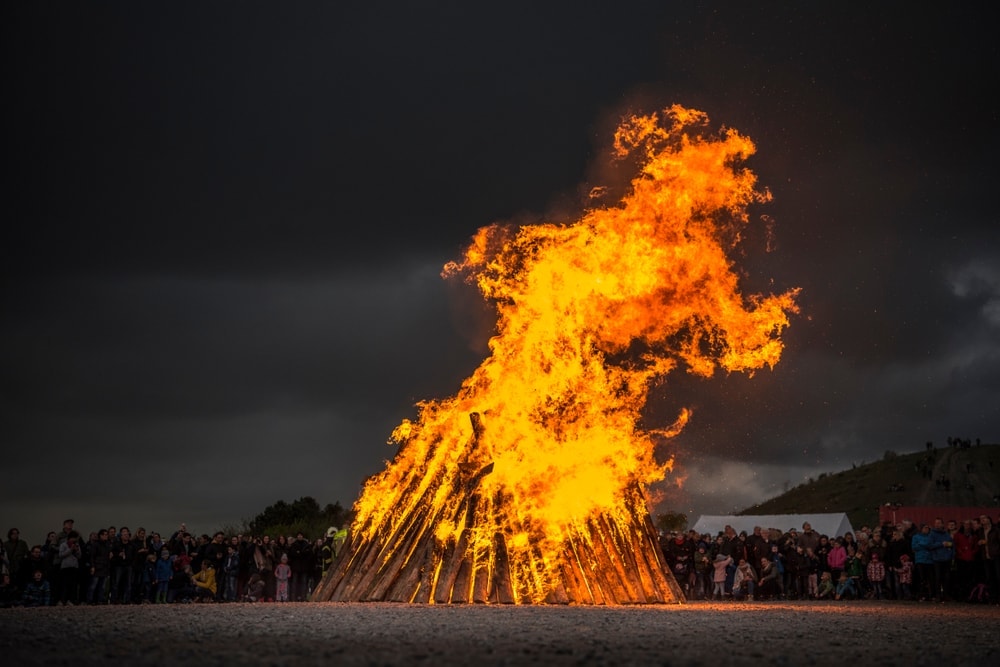
The large size makes bonfires useful for disposing of waste, such as old furniture, unused wood, photos of your ex, or even your kid’s homework. That’s one way to get called a cool parent!
People still light bonfires on special occasions and holidays. For instance, individuals in the United Kingdom often celebrate Guy Fawkes Night with a bonfire. Others just use them for autumn parties.
How Bonfires Are Made
Start by marking the area with rocks or other nonflammable materials. Then, dig a pit to contain the flame. You will need a large burn area, so make sure you have all the necessary permits before starting. Bonfires require a lot of fuelwood and need constant feeding. You can start a bonfire with tinder and kindling as you would any other fire. No flame torches are needed!
Tinder catches the initial flame from the firestarter. Common fire starters include matches and lighters, while tinder can be sawdust, paper, or twigs. Kindling includes small wood strips or large sticks that transition from the tinder to fuelwood. Once the kindling starts burning, you can prepare for the full fire.
Make sure to keep it away from anything flammable and hold it in place with massive logs or wooden pallets placed perpendicular to the ground.
What Is a Campfire?
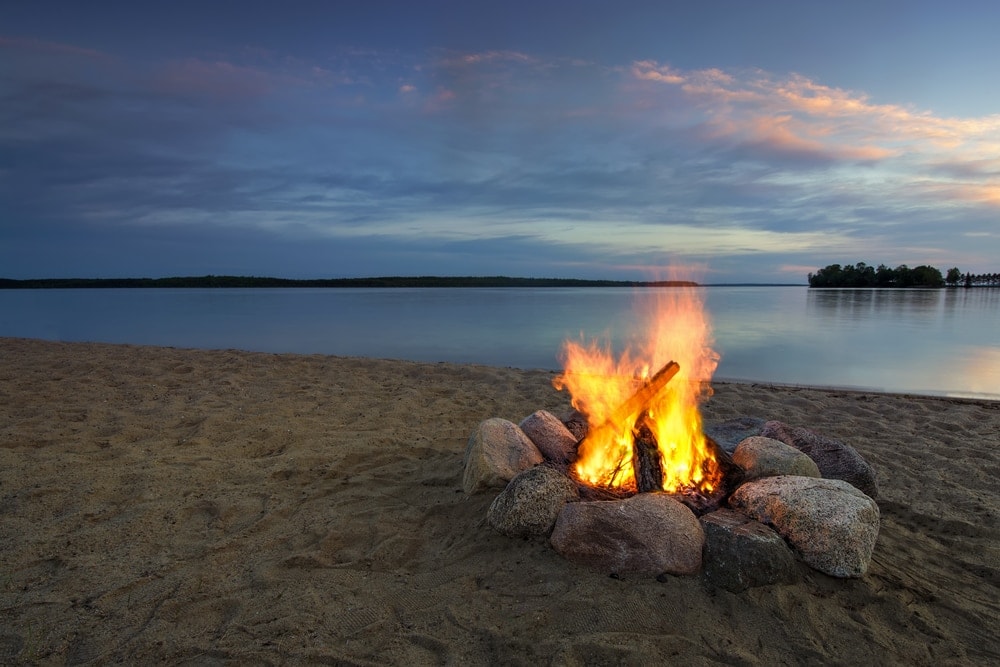
The term campfire refers to small fires built while camping. Usually, the fire maker will place them in a pit or ring so that people can safely gather around them for hanging out, cooking, and warmth. They provide light and protection from bugs. You would usually assemble a simple campfire at campsites, but you can always set up a temporary site in a cleared or open area.
Types of Campfires
There are five main types of campfires.
- Log cabin
- Platform
- Lean-To
- Star
- Teepee
The different types refer to the methods used to construct them. The wood takes on these shapes to cultivate a consistent flame.
Purpose of Campfires
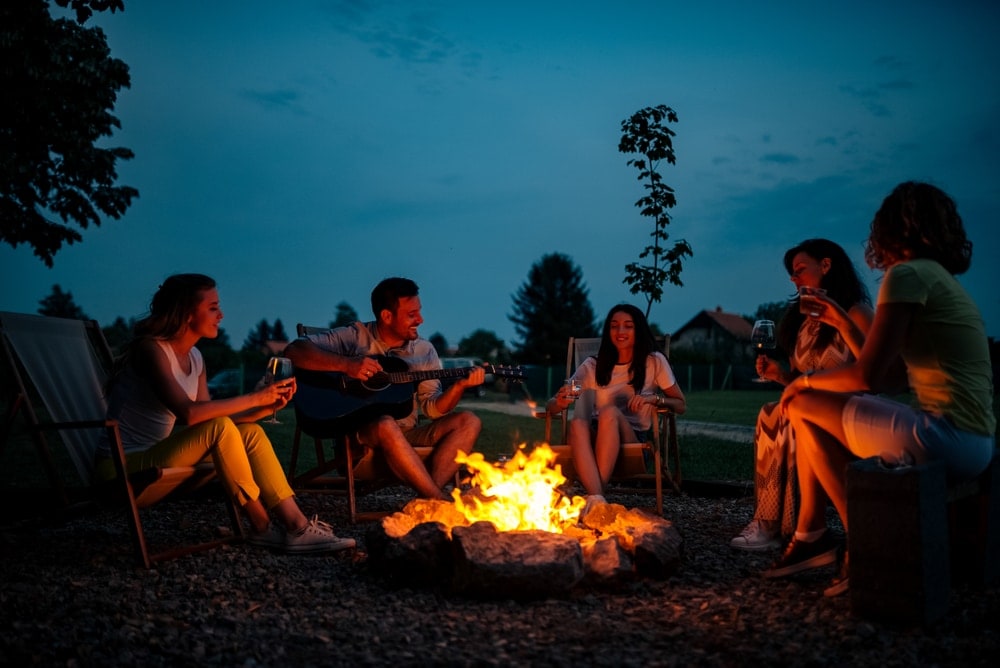
People often connect campfires to “sitting around a campfire.” Campfires are useful for cooking and warmth when out in the woods. Also, they can repel wild animals, mosquitoes, and other pests to keep your campgrounds comfortable. While they do not have a celebratory religious purpose like bonfires, many fun songs and games connect to them.
Scientists have found campfires in Israel dating back 790,000 years, so people have used controlled fires for food and warmth for a huge part of human history.
How Campfires Are Made
You build a campfire with matches, tinder, kindling, firestarters, and fuelwood. Each type of campfire requires a different technique.
Log Cabin
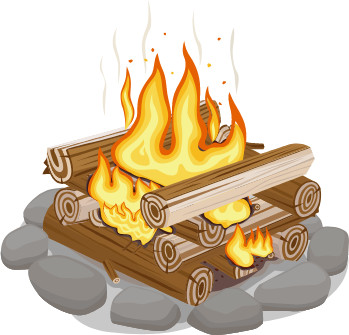
You can build a log cabin campfire by placing two fuelwoods in parallel on the ground. Place the tinder in between the wood and some larger tinder on top. Then, add some kindling across the base wood spaced to allow for airflow. Add more fuelwood perpendicular to the base. You can keep adding more layers as long as you do not cover the kindling.
Since fire burns up, you will want to light it from the bottom. Make sure to reach far enough to light the fire without burning your hand.
Platform
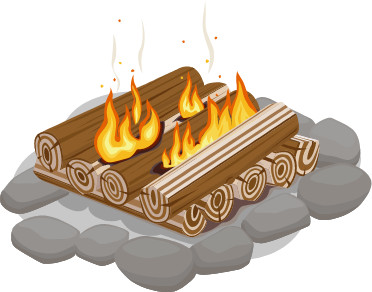
You construct a platform campfire as you would a log cabin one, but you stack the logs closer together and light it from the top.
Lean-To
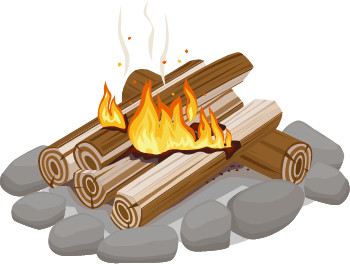
A lean-to campfire makes an excellent choice for beginners, and you can add more layers to the top to make it a log cabin style. While you cannot cook with this method, it can provide light and warmth in strong winds.
Start by placing large fuelwood on the site. Next, lean tinder against the base and add kindling on top. Lastly, you light the tinder and kindling to create the fire.
Star
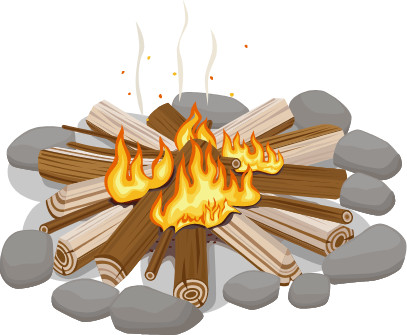
The star formation requires you to line up five fuelwoods by their ends and burn them individually. This method takes little skill, conserves wood, and can handle any log size. However, it does take a while to burn, making it unfavorable for heating.
Teepee
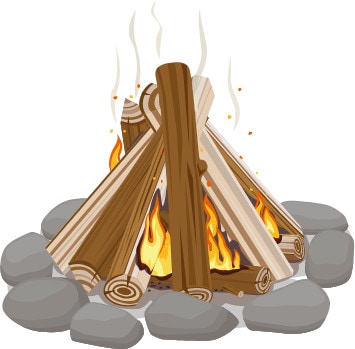
If you want to make a quickfire for heat or cooking, consider a teepee campfire. While it consumes a lot of wood, it can readily cook your food. You start by arranging the tinder on the surface, placing the kindling in a cone shape around the tinder, balancing the kindling, and adding more until you have a solid structure.
You can make teepee campfires out of leaves and twigs if you’d like. Remember that the smaller wood will burn faster, so you will need to tend it frequently.
You may also like: No Dry Wood? No Problem: How To Start A Fire With Wet Wood
Safety Precautions for Campfire vs Bonfire
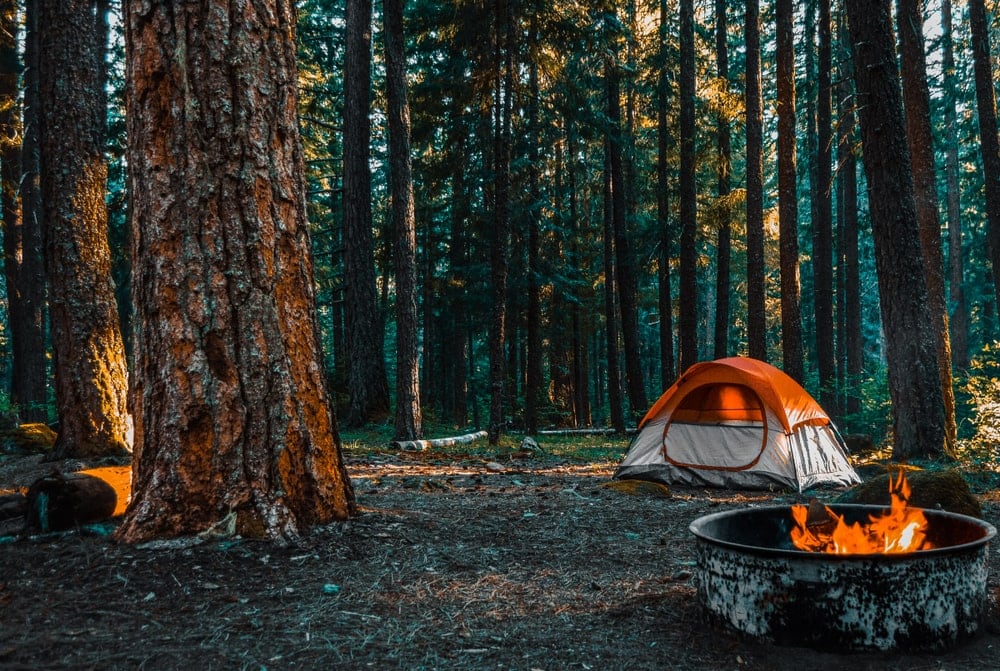
Before you pick up your first twig, figure out if local authorities require a permit to start a campfire or bonfire. Once you have attained the necessary documentation, you can check some weather reports.
A Red Flag or Fire Weather Warning will tell you if your area poses a risk for spreading a wildfire. The National Weather Service issues this warning in adverse conditions. While you can legally start a fire under these weather watches, we do not recommend it. You will need to pay close attention to it nonstop to make sure it does not spread.
Also, make sure to check the weather for wind or rain that could hinder your fire. High winds can eliminate control and spread the fire to nearby plant species by picking up embers. The larger the fire, the more prevalent this danger becomes. Ensure that the campsite does not have anything flammable nearby and opt for a windless night.
Rain could put the fire out and make it challenging to start. However, dry conditions can spread fires rapidly and consume more wood. Conversely, excess condensation adds a protective layer to surrounding wood that makes them less flammable. Check the humidity levels to see if the air is moist enough for a safe campfire.
You May Also Like: Your Guide For Choosing The Best Equipment For Campfire Cooking
Final Thoughts on the Difference Between Bonfire and Campfire
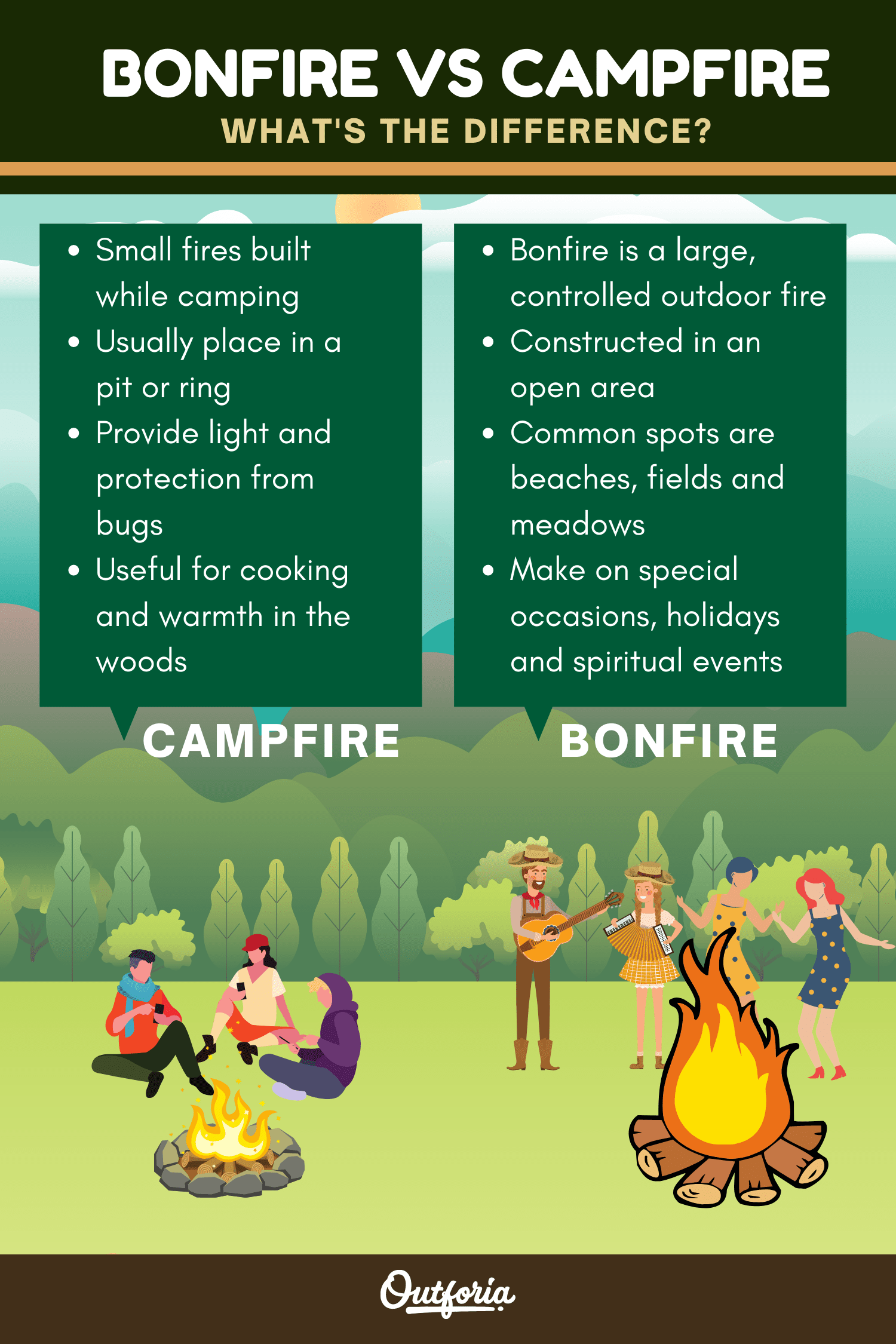
Share this Image On Your Site
<a href="https://outforia.com/bonfire-vs-campfire/"><img style="width:100%;" src="https://outforia.com/wp-content/uploads/2021/06/Infographic-2-Outforia-Bonfire-vs-Campfire.png"></a><br> Bonfire Vs Campfire Infographic by <a href="https://outforia.com">Outforia</a>Campfires and bonfires may both supply heat and light, but they have significantly different uses and terms of size. Campfires are small and useful in camps, as long as you build them safely. You can cook on them and hang out around them. Make sure someone tends and watches the fire to avoid spreading and extinguish them completely before leaving.
Bonfires are huge and generally require permits. You need to build them far from anything flammable. These fires are used in spiritual rituals, celebrations, and ceremonies.
Both campfires and bonfires can provide entertainment, and humans have used them for hundreds of centuries to supply their foundational needs. We continue to use bonfires and campfires today because of the joy, comfort, and sense of community they bring.
You May Also Like: Learn How Hot is a Campfire and The Factors Affecting Your Campfire Temperature: With Facts and Pro Tips
FAQ
Here are some frequently asked questions about bonfire vs campfire.
How Hot Does a Campfire Get?
Fire burns at around 2,012 degrees Fahrenheit, which can melt metals like aluminum. Different colored flames vary in their relative heat as well. White and blue flames burn the hottest, followed by yellow, orange, and ending with red.
What Is the Best Type of Firewood?
Cedar and pine fuelwoods work best for outdoor campfires. They produce a pleasant scent and will cease burning before too long. These woods pose less of a threat than ones like Hickory that will burn for hours and increase the risk of spreading.
How Do I Make My Campfire Smoke Higher?
You can make your campfire smoke higher by starting small and working your way up. The base should have twigs and small sticks while the top has larger logs. The fire will rise higher without producing an excessive amount of smoke.
What Do You Use to Cook on an Open Fire?
We do not recommend placing a pot directly on a flame. You will need to place a metal grate over the fire for your pans. If you need something lightweight, try a non-toxic anodized aluminum. The anodizing process makes it heat-resistant. If you do not care about weight, then a cast-iron skillet will do you well.
You could always go old fashioned and hang something above the fire and rotate it as you cook, but most purposes will require a grate. Make sure to avoid plastic as it can melt and create dangerous emissions.
Can I Start a Campfire in My Backyard?
If your city allows for open flames, then you can get a fire pit and the needed permits to start a fire in your backyard. Make sure to keep the fire at least 25 feet away from buildings, trees, and wooden fences to stay safe. Covering the fire pit when it is not in use will keep it prepared for your next backyard campout.







